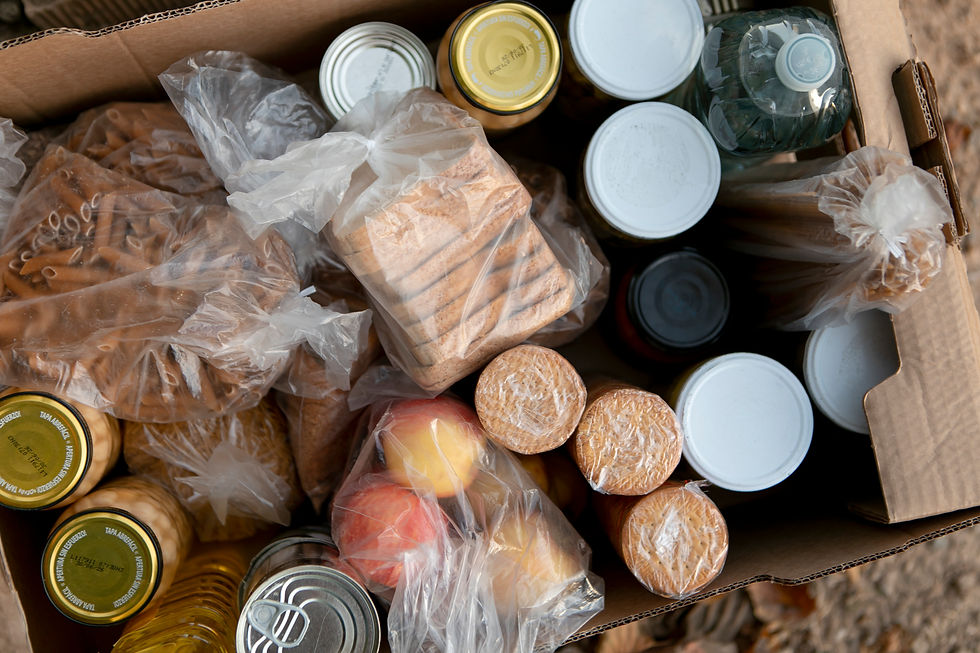Emergency Preparedness: Are You Ready in the Event of a Worldwide Emergency?
- Isabella Boston

- Sep 3, 2023
- 7 min read
Updated: Nov 17
Learn how to plan for food, water, and other survival needs with this exclusive emergency preparedness guide.

Are you ready for a worldwide emergency? Do you know how to survive, or what to do during, a man-made or natural disaster? If not, then you need to have a plan for such an occurrence.
It is very important to keep a reserve of food and other supplies during an emergency. There will come a time when there will be a shortage of food, medical care, and other necessary commodities (Matt. 24:6-7, Luke 21:10-11). As you plan your emergency supply, please include the following items:
Drinking water
Clothing and bedding
Basic food supply
Fuel and Light
Equipment
Important documents
First aid, medications
Ways to communicate
Drinking Water

You cannot live for more than three days without drinking water. Make sure you plan to have at least a 1 to 2 weeks’ supply of water, about 14 gallons per person. This is a minimum. If you have infants, elderly people, and sick people living with you, then you will need to plan for more. Also, if you live in a hot or humid environment, plan on storing more water as well.
This suggested amount does not include water needed for cooking, showers, or baths, so plan on a few extra gallons per person for that too.
You will want to store your water in clean plastic or glass containers. Avoid any commercially bottled water containers that are not PETE (or PET) plastic. Rotate commercial water by the “best if used by” dates printed on the bottles.
Clean and sanitize all containers before use. You can make a sanitizing solution by adding one teaspoon (5 ml) of liquid household chlorine bleach (5 to 6% sodium hypochlorite) to 1 liter (one quart) of water. Do not use household bleach with thickeners, scents, or additives.
Do not use plastic milk jugs. They do not seal well and may become brittle over time.
Do not use containers that were not previously used to store food products.
Store all water away from light!
Water pretreatment
Any water from a chlorinated municipal water supply does not need additional treatment for microorganisms when it is stored in clean, food-grade containers. (If water has chemical toxins in it, then you will need to filter the water with a filtration system to remove them. Please see my "Video Reference" section at the end of this post to learn more.)
Non-chlorinated water needs to be treated with bleach:
Add 8 drops of liquid household chlorine bleach (5 to 6% sodium hypochlorite) for every 4 liters (one gallon) of water. Do not use bleach with thickeners, scents, or additives.
Storage
Store your water in a place where a potential leakage will not damage your home or apartment. You should protect stored water from any heat and light. Depending on the container, you may need to protect your stored water from freezing as well.
To improve the taste of your stored water, pour it back and forth between two containers before use. You should empty and refill your containers regularly.
Water Disinfectant and Purification Methods for an Unknown Water Source
If you are in a situation where you do not know if your water supply is safe or whether it has been polluted, you should purify it before use by following this two-step process:
1. Clarify – If water is cloudy or dirty, it should be passed through fine cloth, filter paper, or some other type of filter. Allow it to settle and then carefully draw from the clear water on top. Always disinfect clear or filtered water before use.
2. Disinfect (boiling method) – You should bring your water to a rolling boil for 3 to 5 minutes to kill most waterborne microorganisms. Do not overboil small quantities of water, because if there are toxic contaminants present, they may concentrate with prolonged boiling.
Bleach method – Add 8 drops of fresh liquid household chlorine bleach (5 to 6% sodium hypochlorite) to every 4 liters (one gallon) of water to kill most microorganisms. Do not use household bleach with thickeners, scents, or additives. This bleach method does not include or address toxic contamination of water (chemicals).
Commercial water filters - A commercial water filter can effectively purify and filter contaminated water with microorganisms, as well as water with toxic chemicals and heavy metals. The effectiveness will depend on the proper use, design, and condition of the water filter.
*Remember, disinfecting water removes harmful bacteria and microorganisms, but water purification removes harmful chemicals and toxins as well.

If you want to invest in a good water purification system, please consider the AquaBrick Portable Water Purification System. It will purify ANY source of non-salt water, making it safe, clean, and portable drinking water.
Emergency Evacuation!

If you must evacuate your home, plan on having enough emergency items for at least 72 hours per person. These items should include:
Clothing: short and long-sleeved shirts, pants, jackets, socks, etc.
Raincoat or poncho
Undergarments
Blankets
Cloth sheets
Plastic sheets
Sleeping bag
Personal supplies and medication
First aid kit and supplies: You can either purchase one or make your own.
Toiletries: Toilet paper, feminine hygiene products, brush, toothbrush, etc.
Cleaning supplies: hand sanitizer, soap, shampoo, dish soap, etc.
Medications: acetaminophen, ibuprofen, children’s medication, etc.
Prescription medications: pack at least three days’ worth, if not more!
Infant’s needs, if applicable.
Personal documents and money (Keep these items in a waterproof container or pouch, especially during an evacuation!)
Legal documents: birth and marriage certificates, wills, passports, contracts, etc.
Medical records.
Insurance policies.
Cash.
Credit card/Checks.
Prepaid phone card.
Food that does not require cooking or refrigeration.
Three-day water supply, one gallon per person.
Trail mix and dried fruit
Granola and protein bars
Crackers and cereals
Canned beans, tuna, turkey, beef, etc. (Pop tops are more convenient.)
Canned juice
Dried meat, jerky

Bunkering Down
For longer-term food supply and when permitted, gradually build a food storage that will last a long time (aim for a full year) and that you can use to stay alive. Some foods, when properly stored, can last 30 years or more. Use and rotate the other packaged and canned items by their “best used by” date. Here is a list of long-term foods:
Wheat (30 yrs +)
White rice (30 yrs +)
Dehydrated Yellow Corn (30 yrs +)
Sugar (30 yrs.+)
Dried beans (30 yrs.+)
Rolled oats (30 yrs.+)
Pasta (30 yrs.+)
Potato flakes (30 yrs.+)
Apple slices (30 yrs.+)
Powered milk (20 yrs.+)
Dehydrated carrots (20 yrs.+)
Canned vegetables
Canned meat
Pancake mix
Peanut butter
Powdered drink mix
Salt
Honey
Mac & Cheese
Tomato soup
Flour
Baking soda
Spaghetti sauce
Jam
Broth
Soup
Food not recommended for long-term storage due to moisture content, oils, and other concerns:
Nuts
Pearled barley
Dried eggs
Dried meat, jerky
Whole wheat flour
Milled grains other than oats
Granola
Use only dehydrated fruits and vegetables dry enough to snap when bent.
Warning: If you store moist products in packaging that reduces oxygen, Botulism, a rare poisoning caused by Clostridium botulinum bacteria, may result and can be fatal and require emergency medical care.
If containers are airtight, you must use oxygen absorbers, and products must be dry (about 10% or less moisture content).
To reduce your risk of bacteria, food-borne insects, and to help preserve nutritional quality and taste, it is recommended that you store food in foil pouches and PETE bottles along with the use of oxygen absorber packets. In certain situations, you can also use plastic buckets for longer-term storage of wheat, dry beans, and other dry products.
When possible, keep containers off the floor to allow air circulation. Please rotate commercial bought food items by their “best used by “ date.
Keep stored products at a temperature of 75 degrees F/ 24 degrees C or lower when possible. If storage temperatures are higher, you must rotate products as needed to maintain quality.
Protect cooking oil and all products stored in PETE bottles from light.

Fuel and Light
Battery lighting: Flashlights, lamps, etc.
Extra batteries
Flares
Lighter
Waterproof matches
Equipment
Radio
Can opener
Dishes and utensils
Shovel
Pen and paper
Pocket knife
Ax
Rope
Duct tape

Ways to communicate:
Cell phone/ text messaging
Landline telephone (will work even when the internet, cellular networks, and infrastructures are down)
Satellite phone: beneficial, especially in remote areas where the internet is scarce.
Two-way radio: Also known as walkie-talkies. A pair of handheld devices that can connect provided both are on the same frequency within a certain distance.
Citizens Band Radio (CB Radio): Capable of short-distance communication on various frequencies.
Amateur Radio (HAM Radio): Similar to CB radio but requires the user to be a licensed American Amateur Radio operator, thus giving the user more authenticity to the information being transmitted across the airwaves.
Police Scanner: This device allows users to hear all emergency communication between officials in the police, rescue, fire, emergency response, military, and aircraft industries. The user cannot broadcast on it, but it does allow access to important information during an emergency.
Word-of-Mouth: When all else fails and the power is out, devices are ruined or lost, and the internet is scarce, use word-of-mouth. This is when having a prior disaster plan in place is crucial to be able to communicate with your family, friends, and loved ones during a time of crisis. If you do not have a plan in place, try not to become isolated from each other and stay together in a group to avoid being separated, lost, or misplaced.
I recommend making a 72-Hour emergency kit for each family member and storing it in a backpack or duffel bag that can be easily carried or lifted.
We are facing challenging times. It is very important to be self-sufficient and prepared in every way. If you live in a place that allows you to grow your garden or food, please do that! Become self-reliant.
Please get your house in order and make right with God in our Lord and Savior Jesus Christ!
May God bless, protect, and watch over us all.
Jesus answered, "I am the way and the truth and the life. No one comes to the Father except through me." ~ John 14:6.
Video References:
Author’s Bio
Isabella Boston
Isabella Boston is a Wordsmith and the creator of Bella’s Attic Studio. She is well-versed in copywriting, articles, research, and medical content writing, with a focus on traumatic brain injury (TBI), autoimmune disorders, and body inflammation. She is a diarist and the author of Passion of Flames.
When Isabella is not writing, she enjoys reading, fashion, learning new languages, and spreading God’s Holy Word.




